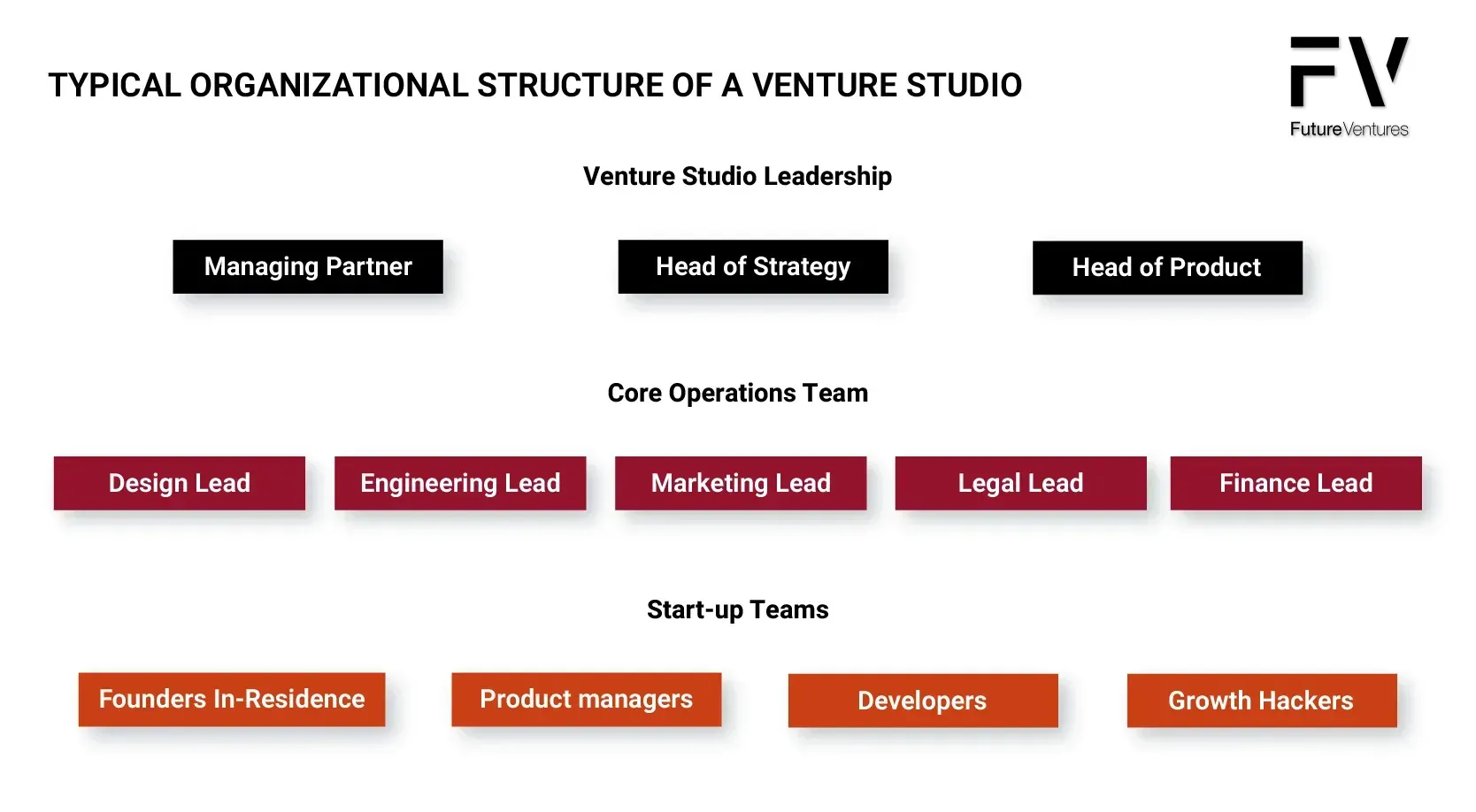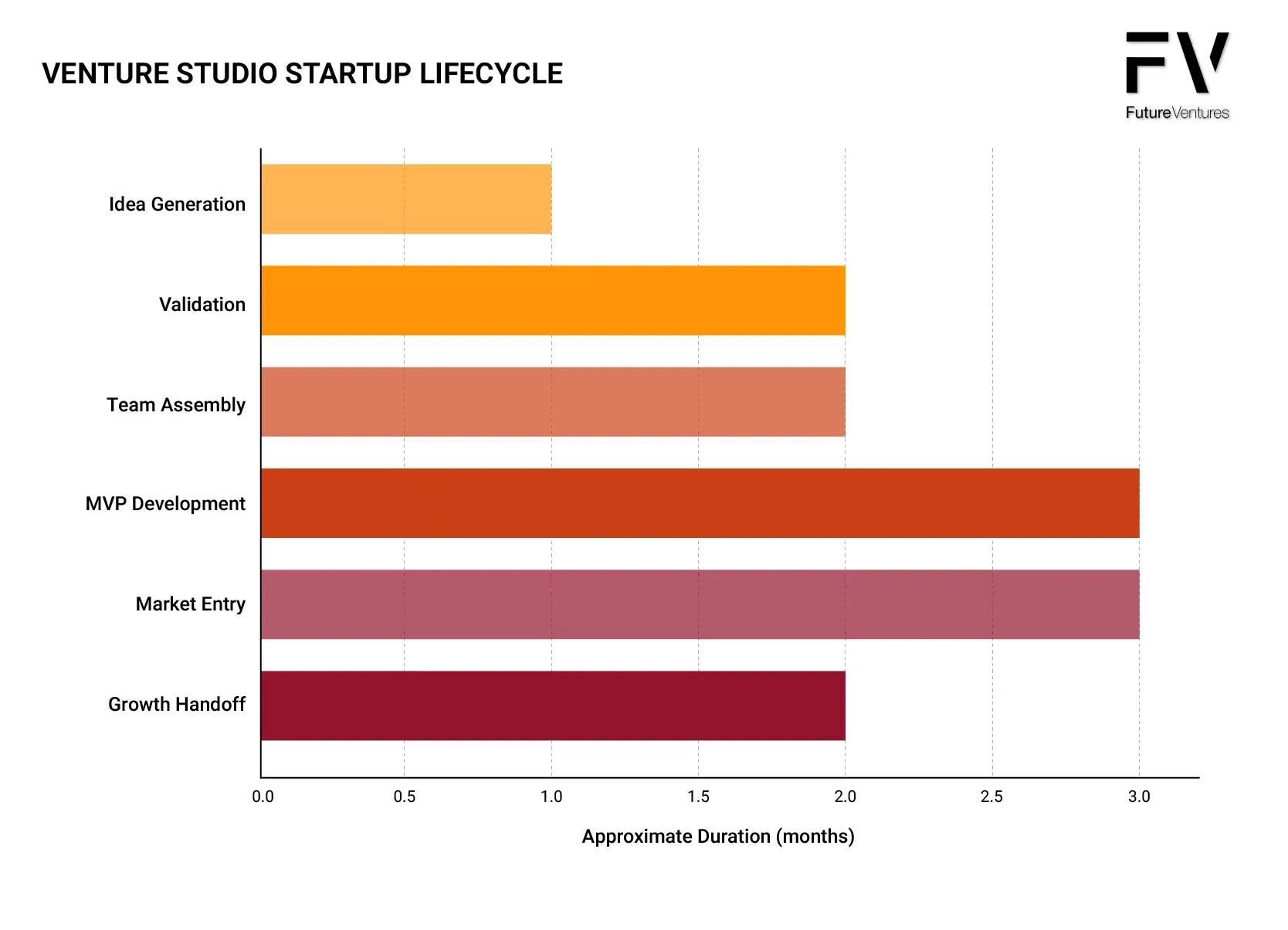What is a Venture Studio: The Playbook Hacking Startup Creation in the Age of AI
"Don’t play the game, own the board."
In a world where startups launch faster than you can say "Series A," a new model is quietly flipping the table: the Venture Studio. This isn't just about chasing unicorns; it's about breeding them—systematically, repeatedly, and efficiently. Let’s dive deep into what makes this model the future of entrepreneurship.
What Is a Venture Studio?
A Venture Studio is a company that creates startups from scratch. Not accelerates them. Not funds them. But builds them!
Think of it as a startup factory, with an assembly line of ideas, talent, and capital. Venture studios generate ideas, test them, assemble teams, and provide the first capital to bring the business to life. They often source business ideas from their own network and assign in-house teams to develop these ideas into startups. Startups developed within a venture studio have immediate access to experienced entrepreneurs and mentors, which significantly enhances their chances of success.
Unlike a startup studio, which focuses on ideating, building, and launching new startups with significant operational involvement and a co-founding role, venture studios are methodical, research-driven, and tech-savvy. They are often funded by external investors and increasingly popping up far from traditional tech hubs like San Francisco—in places like Austin, Berlin, and even Calgary.
Understanding the Venture Studio Model
Definition and Overview
- Venture studios ideate, build, and scale companies in-house as part of the venture studio business model.
- They form and test ideas, hire founding teams, and seed capital from Day Zero.
- Unlike incubators, they don’t wait for founders to walk in—they create founders by design.
- The process of venture studio creation includes a four-stage operational framework of ideation, validation, commercialization, and growth.
- Startups in a venture studio focus on building a minimum viable product (MVP) after forming a founder team.
- Accelerators, on the other hand, focus on accelerating the growth of existing early-stage companies, distinguishing their role from the foundational work of venture studios.
- Incubators often target university students and aspiring entrepreneurs.
Refer to our In-depth Guides on the differences between:
- Venture Studio and Accellerator; and
- Venture Studio and incubator.
The typical organizational structure of a venture studio

Venture Studio Leadership Team
The leadership team in a venture studio is crucial for fostering innovation and risk-taking. They encourage the in-house team to experiment and learn from both successes and failures, creating a dynamic environment for new business ideas to thrive. This culture of innovation ensures that startups can evolve into successful ventures.
Additionally, the leadership team is instrumental in forming strategic partnerships. By leveraging their extensive networks, they secure collaborations that provide startups with essential resources, expertise, and insights. These partnerships are vital for supporting startups through various stages.
Core Operations and Extended Team
Beyond the core leadership team, venture studios typically feature an extended team of professionals who bring specialized skills to the table. This includes:
- Product Managers and Developers: Responsible for translating business ideas into viable products, ensuring that development aligns with market needs and technical feasibility.
- Marketing and Sales Experts: Focus on crafting go-to-market strategies, building brand awareness, and driving customer acquisition to ensure the startup's growth trajectory.
- Financial Analysts and Accountants: Manage financial planning, budgeting, and resource allocation to maintain fiscal health and support strategic decision-making.
- Legal Advisors: Provide crucial guidance on intellectual property, contracts, and regulatory compliance, safeguarding the startup's interests.
- Human Resources Professionals: Oversee talent acquisition, employee engagement, and organizational development to build a strong and cohesive team.
Core teams are made of serial entrepreneurs, data scientists, product nerds, and investors. These individuals bring a wealth of experience and deep industry knowledge, allowing the venture studio to navigate the complexities of startup creation efficiently. Their expertise in various domains ensures that each startup has a solid foundation and strategic guidance from the outset.
Mentors and advisors play a vital role, shaping early strategy and avoiding obvious pitfalls. Their involvement is crucial in the early stages as they provide insights and feedback that help refine business models and product offerings. This mentorship is not only about avoiding mistakes but also about identifying market opportunities and crafting innovative solutions that align with current trends.
Start-up Teams
In a venture studio, startup teams consist of a carefully selected group of professionals who are believed to have the right mix of chemistry, determination, and expertise to turn an idea into a successful venture. These teams usually include experienced entrepreneurs, product managers, developers, marketing specialists, and financial analysts.
Collaborative Environment
Venture studios cultivate a collaborative atmosphere where diverse teams unite to achieve shared objectives. Through regular meetings, workshops, and brainstorming sessions, they foster open communication and innovation, enabling teams to swiftly adapt to shifting market dynamics and new opportunities. This collaborative spirit ensures the efficient transformation of business ideas into successful ventures. By harnessing the collective expertise of the team, venture studios equip each startup to effectively tackle the challenges of early development stages and achieve rapid growth.
Strategic Partnerships
In addition to their internal teams, venture studios often form strategic partnerships with external entities, including industry experts, academic institutions, and corporate partners. These partnerships provide access to additional resources, expertise, and market insights, enhancing the studio's ability to create successful startups.
Venture Studio Startup Lifecycle

1. Business Ideas Generation
- Studios use internal research, market trends, and domain expertise to generate new business ideas.
- They iterate like mad scientists until they hit product-market fit.
- Incubators wait for good ideas; studios manufacture them.
- During the validation stage, the concept is tested to ensure it addresses a real problem and is financially viable.
- The success of each venture is often evaluated through metrics assessing product-market fit and growth potential.
- Grants and subsidies from government entities or industry-specific organizations can provide non-dilutive funding to early-stage tech startups, offering additional financial support during the validation phase.
- Incubators provide support to early-stage companies but do not usually help with daily operations.
Validation
1. Market Opportunities
Identifying market opportunities is a cornerstone of the venture studio model. Venture studios employ a variety of methods to uncover potential market gaps, including rigorous market research, in-depth customer interviews, and expert analysis. They also tap into their extensive network of partners, investors, and industry experts to gain insights into emerging trends and technologies. By pinpointing market opportunities early, venture studios can craft business ideas that resonate with market needs and have a higher likelihood of success.
Key factors considered when identifying market opportunities include:
- Market Size and Growth Potential: Assessing the overall market size and its growth trajectory to ensure the opportunity is substantial and sustainable.
- Competition and Market Saturation: Analyzing the competitive landscape to identify gaps and areas with less saturation.
- Customer Needs and Pain Points: Understanding the specific needs and challenges of potential customers to tailor solutions that address real problems.
- Emerging Trends and Technologies: Keeping an eye on new trends and technological advancements that could disrupt or enhance the market.
- Regulatory Environment and Barriers to Entry: Evaluating the regulatory landscape to anticipate potential hurdles and compliance requirements.
By meticulously evaluating these factors, venture studios can align their business ideas with their expertise and resources, setting the stage for successful startup creation.
2. Business Model and Structure
- Venture studios bundle the startup lifecycle—ideation to execution—into a single platform.
- They act as co-founders, not just sponsors.
- Unlike VC firms, their ROI is tied to creation, not just investment.
- Venture capital gives startups access to a network of VC Firms, angel investors, and limited partners who can offer strategic guidance, complementing the studio's hands-on approach.
Developing a Competitive Business Model
Crafting a competitive business model is pivotal in the venture studio model. Venture studios utilize various tools and frameworks to design business models that are not only innovative but also tailored to the specific market and business idea. Leveraging their deep expertise and resources, they develop models that are scalable, sustainable, and profitable.
Key considerations in developing a competitive business model include:
- Revenue Streams and Pricing Strategy: Identifying multiple revenue streams and setting a pricing strategy that maximizes profitability while remaining attractive to customers.
- Cost Structure and Operational Efficiency: Streamlining operations to minimize costs and enhance efficiency, ensuring the business can scale effectively.
- Customer Acquisition and Retention Strategy: Developing robust strategies for acquiring new customers and retaining existing ones, focusing on long-term growth.
- Marketing and Sales Strategy: Crafting a comprehensive marketing and sales plan that positions the business strongly in the market.
- Competitive Landscape and Market Positioning: Analyzing competitors and positioning the business uniquely to stand out in the market.
By carefully considering these factors, venture studios can develop business models that are not only competitive but also poised for long-term success.
3. Investment and Funding
Investment Criteria
- Scalability, disruption potential, and strong team dynamics are table stakes.
- Market size is critical, but so is timing.
- Studios often favor frontier tech: AI, climate, fintech, etc.
Team Assembly
Startup Creation
- Studios build from internal IP, often spinning out 3-5 companies per year.
- It’s entrepreneurship with a blueprint—and an in-house construction crew. Venture studios recruit startup founders to assemble founding teams, create and validate new startups, and support them through growth until exit.
- The method is repeatable, and that’s the magic: systematized innovation.
- Venture studios can spread and mitigate the inherent risks of startup development by working on multiple projects simultaneously.
- Venture studios generally hold more equity in their startups compared to accelerators and incubators.
Creating a New Business
Creating a new business is the ultimate goal of the venture studio model. Venture studios leverage their extensive expertise and resources to transform business ideas into thriving startups. They provide crucial funding, mentorship, and support, guiding entrepreneurs through the complex journey of building a new business.
Key steps involved in creating a new business include:
- Developing a Business Plan and Financial Projections: Crafting a detailed business plan with clear financial projections to guide the startup’s growth.
- Building a Team and Recruiting Talent: Assembling a talented team that can execute the business idea effectively.
- Securing Funding and Resources: Obtaining the necessary funding and resources to support the startup’s development and growth.
- Developing a Product or Service: Creating a product or service that meets market needs and stands out from the competition.
- Launching and Marketing the Business: Strategically launching the business and implementing a robust marketing plan to attract customers and drive growth.
By providing comprehensive support and resources, venture studios help entrepreneurs navigate the challenges of building a new business, significantly increasing their chances of success.
MVP Development
Minimum Viable Product (MVP) development is a critical phase in the venture studio model, as it allows startups to test their core ideas with minimal resources. This phase focuses on creating a simplified version of the product that includes only the essential features necessary to validate the business concept and gather user feedback.
Key Steps in MVP Development
- Identifying Core Features: The first step in MVP development is to identify the core features that address the primary problem the startup aims to solve. This involves prioritizing features that provide the most value to users and differentiating the product from competitors.
- Rapid Prototyping: Venture studios leverage their in-house teams of developers and designers to create rapid prototypes. This process involves quickly building a functional version of the product to test its usability and gather early feedback from potential users.
- User Testing and Feedback: Once the prototype is ready, it is tested with a select group of users to gather feedback on its functionality, design, and overall user experience. This feedback is crucial for identifying areas of improvement and refining the product.
- Iterative Development: Based on user feedback, the MVP is iteratively improved, with adjustments made to features, design, and functionality. This iterative process ensures that the product evolves in alignment with user needs and market demands.
- Market Validation: The final step in MVP development is market validation, where the product is introduced to a broader audience to assess its market fit and demand. This stage provides valuable insights into the product's potential for success and guides future development efforts.
Benefits of MVP Development in Venture Studios
- Risk Mitigation: By focusing on essential features and gathering user feedback early, MVP development reduces the risk of investing in a product that may not meet market needs.
- Cost Efficiency: Developing a simplified version of the product minimizes initial development costs, allowing startups to allocate resources more effectively.
- Faster Time to Market: The MVP approach enables startups to launch their products more quickly, gaining a competitive edge and establishing a market presence sooner.
- User-Centric Design: Continuous user feedback ensures that the product remains aligned with user preferences, increasing the likelihood of adoption and success.
By embracing MVP development, venture studios can efficiently validate business ideas, refine their offerings, and set the stage for successful market entry and growth.
Market Entry and Growth
Market Entry Strategies
- Partnership-first: piggybacking off industry giants.
- Acquisition: enter fast by buying speed.
- Organic: the good old way—but turbocharged with studio resources.
- Accelerators provide opportunities for startups to pitch to multiple investors at once, offering a different pathway to growth compared to the partnership-driven strategies of venture studios.
- Accelerators typically offer shorter programs, lasting only a few months.
- Business development: establishing operational frameworks and growth plans is crucial for market entry and scaling. This phase ensures that the startup is ready for market entry by developing robust branding, marketing strategies, and operational structures.
Go-to-Market (GTM) Execution
- Studios deploy cross-functional GTM teams to test channels.
- Data is king: no intuition-based launches here.
Growth Handoff
The growth handoff is a pivotal moment in the venture studio model, marking the transition from startup development to scaling and expansion. This phase involves transferring the startup from the nurturing environment of the venture studio to external investors or strategic partners who specialize in scaling businesses. The goal is to ensure that the startup has a solid foundation, a validated business model, and a minimum viable product (MVP) ready for rapid growth.
Key Elements of a Successful Growth Handoff
- Strong Foundation: Before the handoff, venture studios ensure that the startup has a robust operational framework, an experienced leadership team, and a clear value proposition. This foundation is crucial for attracting external investors and partners.
- Validated Business Model: A key aspect of the growth handoff is having a well-tested and validated business model. This includes proven revenue streams, a scalable cost structure, and a clear path to profitability.
- Established Market Presence: The startup should have achieved some level of market traction, with a growing customer base and positive feedback on its MVP. This market presence is essential for convincing investors of the startup's potential for success.
- Strategic Partnerships: Venture studios often facilitate strategic partnerships with industry leaders, corporate partners, or other stakeholders to provide additional resources and support during the growth phase. These partnerships can offer valuable market insights, distribution channels, and technological expertise.
- Investment Readiness: The startup is prepared for the next round of funding, with detailed financial projections, a compelling pitch deck, and a clear growth strategy. This investment readiness is critical for securing the necessary capital to fuel expansion.
Benefits of a Successful Growth Handoff
- Accelerated Growth: With the right partners and resources, startups can achieve rapid growth and scale their operations more effectively.
- Access to Expertise: External investors and partners bring additional expertise and experience, helping startups navigate the complexities of scaling.
- Increased Valuation: A successful growth handoff can lead to a higher valuation, making the startup more attractive to future investors and potential acquirers.
- Sustainable Expansion: By building on a strong foundation, startups can pursue sustainable growth strategies that ensure long-term success.
The growth handoff is a critical step in the venture studio business model, enabling startups to transition from the nurturing environment of the studio to the broader market, where they can achieve their full potential. By carefully managing this transition, venture studios set their startups up for success in the competitive startup ecosystem.
Advantages of the Venture Studio Model
Innovation and Risk-Taking
- Studios encourage failure – fail fast, fail cheap.
- With shared resources, they take bolder bets.
- The culture is part lab, part dojo.
Efficiency and Cost-Effectiveness
- Shared infrastructure: legal, HR, engineering, design.
- Economies of repetition: every new startup benefits from what the last one learned.
- Cost per startup drops as the playbook sharpens.
- Venture studios reduce overhead costs for startups by providing shared administrative resources.
- Being part of a studio gives startups access to a broader network of partners and stakeholders.
- Venture studios may provide services like finance, recruiting, marketing and PR, design and branding, and product-market fit, further streamlining the startup journey.
- Knowledge and experience compound with each business that passes through a studio.
Corporate Venture Studios
Overview
- Large companies are launching internal studios to reignite innovation.
- Think of it as a sidecar to their core business – agile, experimental, free.
- Corporate studios benefit from brand, distribution, and data access.
Benefits and Advantages
The venture studio model offers numerous benefits and advantages to entrepreneurs and startups. Some of the key benefits include:
- Access to Funding and Resources: Venture studios provide essential funding and resources, reducing the financial burden on startups.
- Mentorship and Support from Experienced Entrepreneurs and Investors: Startups benefit from the guidance and expertise of seasoned entrepreneurs and investors.
- Access to a Network of Partners and Industry Experts: Venture studios offer a vast network of partners and industry experts, providing valuable insights and opportunities.
- Ability to Develop Business Ideas into Successful Startups: The structured approach of venture studios helps transform business ideas into successful startups.
- Opportunity to Build a Scalable and Sustainable Business: With a focus on scalability and sustainability, venture studios help startups build businesses that can grow and thrive in the long term.
By offering these benefits, venture studios empower entrepreneurs and startups to build successful businesses and achieve their goals.
Exit Strategy for Studios
- Studios typically exit via M&A or by attracting later-stage VCs.
- Founders (sometimes studio employees) may buy equity over time.
- Returns can rival or exceed VC funds, thanks to ownership concentration.
Focus on Early-Stage Startups
- Studios live in the pre-seed and seed stages.
- It’s messy, chaotic, and idea-rich—exactly where studios thrive.
- The goal? Get to MVP + traction fast, then hand it off to scale-focused investors. Venture studio startups, in particular, exhibit a significantly higher success rate in achieving this compared to traditional startup methods.
Challenges and Considerations
While the venture studio model presents numerous advantages, it also comes with its own set of challenges and considerations. Some of the key challenges include:
- Identifying Market Opportunities and Developing Competitive Business Models: Finding the right market opportunities and crafting competitive business models can be complex and resource-intensive.
- Securing Funding and Resources: Obtaining the necessary funding and resources to support multiple startups simultaneously can be challenging.
- Building a Team and Recruiting Talent: Attracting and retaining top talent is crucial for the success of startups but can be difficult in a competitive market.
- Managing Risk and Uncertainty: The inherent risks and uncertainties of startup development require careful management and strategic planning.
- Scaling and Growing the Business: Ensuring that startups can scale effectively and sustain growth over time is a critical challenge.
By carefully evaluating these challenges and developing strategies to address them, venture studios can enhance their chances of success and continue to innovate in the startup ecosystem.
Comparison Table: Venture Studio vs. Other Models
| Feature | Venture Stud | Incubator | Accelerator | VC Fund |
|---|---|---|---|---|
| Idea Source | Internal | External (founder | External (founders) | External (founders) |
| Team Assembly | In-house | Founder-led | Founder-led | N/A |
| Capital Provided | Early-stage (pre-seed) | Often none | Seed-stage | All stages |
| Support Duration | Long-term | Short-term | Fixed-term | Ad hoc |
| Revenue Model | Equity | Rent or small equity | Equity | Equity |
| Focus | Systematic startup creation | Founder support | Founder support | Funding only (traditional venture capital funds) |
Final Thoughts
If venture capital is betting on horses, venture studios are building the stables. In a world where speed, precision, and iteration matter more than luck and charisma, studios offer a modernized, technology-first path to startup success.
In the next decade, the most valuable startups may not be born in garages—but on assembly lines.
Citations
- Blank, Steve. The Startup Owner's Manual: The Step-by-Step Guide for Building a Great Company. K & S Ranch, 2012.
- CB Insights. “How Venture Studios Are Disrupting The Startup Model.” https://www.cbinsights.com
- Galloway, Scott. The Four: The Hidden DNA of Amazon, Apple, Facebook, and Google. Portfolio, 2017.
- Harvard Business Review. “Corporate Venture Studios: Accelerating Innovation From Within.” https://hbr.org
- McKinsey & Company. “The Rise of Venture Studios: Systematizing Innovation.” https://www.mckinsey.com
- Sokoloff, Andrew. “The Studio Model: Creating Startups with Repeatable Success.” Medium, https://medium.com
- Wilson, Fred. “Venture Studios vs. Accelerators vs. Incubators.” AVC Blog. https://avc.com
- Rosen, Michael. “Comparing Startup Funding Models: Studio vs. VC.” TechCrunch. https://techcrunch.com










